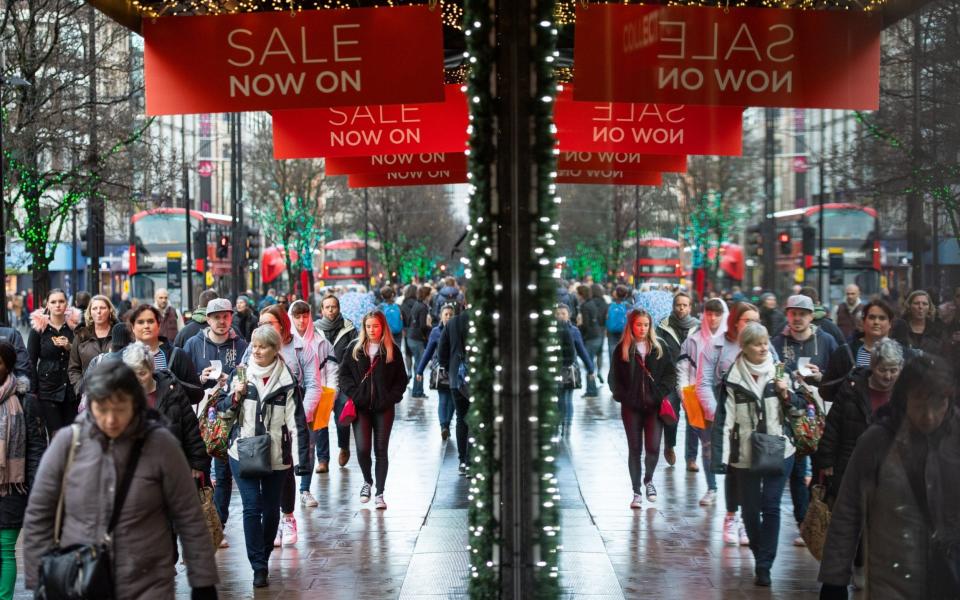Oxford Street: The Survey of London, review: the history of a very strange (and British) street

DH Evans opened a restaurant on the fifth floor of its rebuilt Oxford Street department store in 1937 that could serve 1,000 (mostly ladies) at once. By then J Lyons was running 10 outlets in the street to refresh the human torrent that has thronged the one mile and 620 yards of the world’s oldest continuously successful shopping street for more than 200 years.
Until just now, that is. The coronavirus has closed shops that the Blitz could not. By 1832, a bus every three minutes plied on this route from Paddington to the Bank. By 1840, 16 tons of horse manure a week were shovelled from the roadway. By 1913, the buses went past Marble Arch every 12 and a half seconds.
Shoppers poured out of the “Twopenny Tube” bored deep under its length in 1896. Its platforms were of timber and the way out was by lifts and stairs, not escalator, but the Tube was electric from the beginning. Oxford Street had been spared the steam Underground built by cut-and-cover construction because the shopkeepers united against having the road dug up. They remembered the months of misery when the middle-level sewer was laid in 1864.
What a strange street it is. Just one pub, the Flying Horse (its 18th-century name, before it lapsed into a spell as the Tottenham, until 2015). No church – one being demolished in 1400.
It’s more a road than a street, since it goes somewhere. It was generally called the Tyburn Road until the middle of the 18th century, when Oxford Street took the ascendancy. As the road to Oxford it lurches to the right to become the Edgware Road, along old Watling Street, which may take its line from a pre-Roman crossing of the Thames at Westminster.
Always by luck, Oxford Street hung on to prosperity as a coalition of individual retailers, mostly living over the shop, along a gravel ledge running east-west above the slope down to Mayfair. Where the street dipped a little to cross Tyburn Brook (by today’s South Moulton Street), stood the Hog in the Pound, where Catherine Hayes the landlady was burnt at the stake for the murder of her husband. That was not in the Middle Ages but in 1726.

Being the way to the gallows at Tyburn brought crowds periodically, but not the sort of customers wanted in the front rooms of solid families of glovers, hatters, haberdashers, mercers and furriers. They were glad to see the back of Tyburn executions in the 1780s. Then the success of the New Road, running parallel to the north, took away the heavier through-traffic. In 1770 the pavements were improved. By 1786 Argand lamps, burning whale oil, made evening shopping attractive. “Up to 11 o’clock at night there are as many people along this street as at Frankfurt during the fair,” Sophie von la Roche wrote home to Germany that year.
Commercial success prevailed not by surfing on waves of eager shoppers, but by trying out new ways of marketing. In 1814, the stupendous Neo-Classical Pantheon closed as assembly rooms for fashionable routs, hurries, tumults and kettle-drums. It was succeeded by a spacious bazaar. A bazaar was a sort of prototype department store where different small traders showed off their wares. The Corinthian Bazaar in Argyll Street did not last long before being converted into what is now the London Palladium theatre.
Owen Jones, the design genius who had made Osler’s glass shop at No 44 Oxford Street a glowing, sparkling tunnel of light, brought into being the London Crystal Palace Bazaar, developing a success from the Great Exhibition. It was admired but did not pay and was swallowed up by Peter Jones in the 1920s.
Department stores proper came in piecemeal. The names are nostalgic: Marshall & Snelgrove from the 1870s, Peter Robinson on three simultaneous sites, John Lewis near DH Evans on the favoured north side, Bourne & Hollingsworth eating up a block near Wells Street. Shopgirls were housed at first in grim dormitories above the stores, until dedicated hostels were built by John Lewis, DH Evans and Bourne & Hollingsworth, still operating between the wars.
No department store was more imposing than Selfridges, projecting its own myth with stunts such as displaying the plane in which Blériot had flown the Channel in 1909. The architecture projected magnificence. It is simply “the grandest masonry shop frontispiece anywhere in the world”, says Andrew Saint, the editor of this volume.

Architecturally, Oxford Street has seldom been up to much. Never planned, unlike Regent Street, its finest buildings are Edwardian.
On the south side, the Grosvenor Estate imposed the French mansarded style in the 1860s, overtaken by the red-brick Queen Anne style preferred by the 1st Duke of Westminster, as chosen for the north side too by the Portland Estate. The one Modern Movement building of note, HMV from 1939, survives as a facade alone. The greatest threat came in 1961, with a plan for a first-floor deck 18ft above the roadway, with a flyover at Oxford Circus.
Oxford Street, illustrated throughout, building by building, forms the 53rd volume of the Survey of London, and the first in the series devoted to a single street.
The survey, a wonderful enterprise of a very English kind (like the Oxford English Dictionary) published its first volume in 1900, and has adapted with the times: all the previous volumes are available to read free of charge online. In its ups and downs and survival, the survey resembles Oxford Street.
Oxford Street: The Survey of London, Volume 53 is published by Yale at £75

